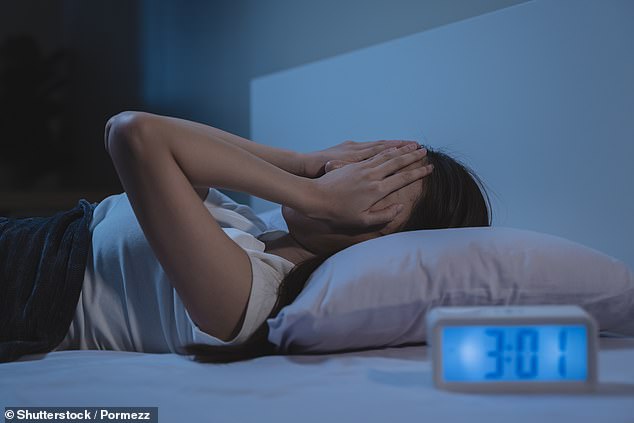Heart pounding, sweating, gasping for breath… chances are you’ve woken up feeling like this at least once in your life – perhaps even in the last week.
Nightmares play havoc with your sleep, transporting you from the comfort and safety of your bedroom to a terrifying dreamscape.
But we all know that bad dreams – whether the bogeyman under the bed, giving a work presentation naked or sitting your finals again – aren’t real, so they can’t hurt you… right?
Wrong, say experts at Imperial College London, whose ground-breaking research, presented at the European Academy of Neurology Congress a fortnight ago, reveals some alarming truths about what happens when we sleep.
Such is the impact of nightmares on your mental and physical health, they found, that having them frequently – once a week or more – can triple your risk of death before the age of 70.
In fact, bad dreams are ‘a stronger predicator of premature death’ than other known risk factors, including smoking, obesity and lack of exercise.
The study, which analysed data from more than 2,400 children and 183,000 adults over 19 years, is the first of its kind to link nightmares with biological ageing.
Sleep experts cannot overstate how significant this is, with lead researcher Dr Abidemi Otaiku of the UK Dementia Research Institute insisting they constitute ‘a public health concern’.

Researchers have found that having nightmares once a week or more can triple your risk of death before the age of 70
With one in 20 of us – or 3.5 million people – afflicted by weekly nightmares (and up to half the UK population experiencing them once a month), it’s an alarming revelation.
So why do some of us suffer from bad dreams? Are certain nightmares worse than others? And what – if anything – can you do to stop them?
Blowing a fuse while you sleep
At a basic physiological level, all mammals, from whales to guinea pigs, experience something akin to dreaming – and are therefore susceptible to nightmares.
In humans, explains Dr Justin Havens, a psychological trauma therapist and leading nightmare expert, dreaming serves as overnight therapy.
‘We dream for a purpose – it’s an evolutionary survival mechanism. We’re trying to digest the emotional experiences of the day,’ he adds.
‘Nightmares occur when this process doesn’t work or is interrupted mid-cycle; like a fuse blowing while you sleep.’
Guy Leschziner, professor of neurology and sleep medicine at King’s College London, says nightmares evolve from dreams whose subject matter is distressing or traumatic.
‘We think that one of the functions of dreaming may be to consolidate memories, but to gradually cause strong emotions linked with these memories to fade,’ he explains.
‘However, if the emotional content of those dreams or nightmares is very high, you will wake up and this process cannot be completed.
‘It means that these emotional memories are never properly dealt with and those strong emotions persist.’
And if you think you don’t dream, you’re wrong. You simply don’t remember it.
Everyone dreams, for roughly two hours every night, mostly during a deeper stage of sleep called REM (‘rapid eye movement’) – a period of increased brain activity characterised by quick, darting eye movements beneath closed eyelids.
The last hour of sleep is nearly all REM sleep, so any nightmares you’re having when your alarm goes off are likely to linger.
The term ‘nightmare’ originates from Old English, with ‘mare’ being a female demon who was thought to sit on the chest and torment sleepers with terrifying dreams and feelings of suffocation.
Excess cortisol equals faster ageing
Scientists are still unsure which parts of the brain serve as the projection booth for nightmares.
But key to what’s happening are thought to be the amygdala, found near the brain stem, as well as the prefrontal cortex, located behind the forehead.
The amygdala is, functionally speaking, where your ‘demons’ are kept; it controls emotions such as aggression, fear, anger and sadness.
When you’re awake, the prefrontal cortex stops these feelings from becoming too dominant. But during sleep, it shuts down – meaning the monsters lurking inside your mind come out to play.
Mentally, explains Tom Stoneham, a professor of philosophy at the University of York, the impact of a nightmare can leave your body ‘in a high state of emotion’.
‘In the immediate aftermath, it is the emotional effects of the nightmare and not the specific content that grips us,’ he says.

Dr Abidemi Otaiku, of Imperial College London, has labelled the significant effects of nightmares ‘a public health concern’
Nightmares can trigger feelings of anxiety, depression and general unease – which sometimes last hours or even days.
A 2020 study in the journal Psychoneuroendocrinology found that participants’ moods were notably lower the day after they had a nightmare, compared with days following neutral dreams. There can be profound physical effects, too.
‘Nightmares lead to prolonged elevations of cortisol, a stress hormone closely linked to faster cellular ageing,’ explains Dr Otaiku, author of the Imperial study.
A 2019 study in the journal Psychophysiology found that bad dreams are accompanied by increased activation of the autonomic nervous system (which regulates functions including heart rate, blood pressure, digestion and sexual arousal).
The after-effects of this – increased body temperature, shallow, rapid breathing and muscle tension – can last long after you wake up.
The gender gap affecting our sleep
According to a 2014 study, women report having more nightmares than men; they’re also able to recall them with greater clarity.
Female sleepers dream about different things, according to a 2014 paper published in the journal Sleep, with nightmares revolving around interpersonal conflict.
Men, by contrast, are more likely to dream about disasters, earthquakes or wars.
Experts believe the female tendency towards nightmares is related to changes in body temperature and increased hormonal levels during the menstrual cycle, as well as higher average stress levels.
Children are more likely to experience nightmares, too, especially between the ages of three and six.
‘We think that some of this may be evolutionary,’ says Deirdre Barrett, a dream researcher at Harvard Medical School and editor of Trauma and Dreams.
‘Children are smaller and are vulnerable to many more threats than adults. Nightmares may partially reflect this vulnerability.’
But sleep expert Dr Nerina Ramlakhan says childhood nightmares aren’t always cause for concern.
‘If they are frequent, they can affect energy levels, ability to concentrate and learn, and increase daytime anxiety,’ she explains. ‘However, they are also normal and can be related to processing emotions, new experiences and creativity.’
Why first-borns have more nightmares
Scientists think the seeds of future nightmares may be planted early in life, before the age of three-and-a-half – a time from which we usually remember very little.
If this period is disrupted by a traumatic event, causing fear or stress, our brains develop coping mechanisms – far earlier than normally required – which can upset the delicate balance.
This traumatic event doesn’t have to be anything out of the ordinary: it can be as simple as the birth of a sibling, causing the elder child to feel forgotten or unloved.
A 2017 paper reported that first-born children had frightening dreams more than twice as frequently as later-born siblings.
Other causal factors include stress – whether at home or from a busy job – grief, and post-traumatic stress disorder, common in military veterans and victims of violent crimes, among whom the incidence of nightmares rises to between 71 and 96 per cent.

Most people will admit to having had a nightmare about falling from a great height; sitting an exam unprepared; being late for something important; being chased; or being unexpectedly naked at work, school or on stage
Bryony Sheaves, a research clinical psychologist at the University of Oxford, has connected nightmares to three temperamental traits: paranoia; frequent ‘de-personalisation’ (a feeling of detachment from yourself or your surroundings); and hallucinations.
But these don’t refer to medical conditions. People vulnerable to nightmares may simply be more suspicious of others, feel stressed in social situations or have vivid, dreamlike imaginations.
‘In reality, there is not one single cause,’ says Dr Sheaves.
The scary dreams that prepare us for real-life horrors
Stemming from our subconscious, nightmares are very personal – but some bad dreams are, statistically speaking, more common and more likely to recur.
Most searched-for online is the nightmare in which your teeth fall out, said to reflect a life change, recent loss or stressful event.
Second most-frequent are dreams about snakes, reportedly triggered by a personal transformation, such as a new job or house move.
And third most common are dreams about pregnancy, which are connected to big developments, especially something exciting or unknown.
Then, of course, there are the dreams we’ve all had at least once: falling from a great height; sitting an exam unprepared; being late for something important; being chased; or finding yourself unexpectedly naked at work, school or on stage.
Dr Justin Havens says none of these should be cause for concern – it’s the really traumatic, aggressive nightmares that are more likely to do damage.
Particularly bad ones, he says, involve ‘either dying or being tortured, or nightmares of traumatic events that have already happened’.
Prof Stoneham, however, says nightmares affect us all in different ways.
‘A dream of spiders would have very different effects on an arachnophobe, an entomologist and someone who lived in a culture where spiders were eaten or had some other similarly positive role,’ he explains.
Indeed, when ‘scary’ subjects appear in our nightmares, this can sometimes be a good thing.
A 2019 study at the University of Geneva found that bad dreams may help prepare us for frightening real-life situations by activating parts of the brain – the insula and the cingulate cortex – which are responsible for the ‘fight or flight’ response to danger.
Could you be suffering from a nightmare disorder?
‘If nightmares are occurring regularly, then they might be classified as a nightmare disorder,’ explains Dr Ramlakhan.
‘This is a pattern of repeated frightening and vivid dreams that cause significant emotional distress and impair functioning.’
We are, however, notoriously bad at doing anything about our bad dreams – particularly in the cold light of day. ‘No one goes to their GP saying: “Help, I’m having nightmares”,’ says Dr Havens.
So when should you worry? ‘Nightmare disorder ranges in severity based on the frequency of nightmares,’ explains Dr Ramlakhan.
‘Mild is less than one nightmare per week. Moderate is one or more nightmares per week, but less than nightly. Severe is nightmares every night.’
It can also vary in duration, with chronic nightmare disorder lasting six months or longer. Ultimately, when – or if – you seek help is up to you.
‘If they’re frequent, disrupting your sleep and your psychological health, and having a big impact on your quality of life, then it’s probably worth talking to someone,’ explains Prof Leschziner.
The red flags nobody should ignore
Experts say persistent bad dreams can be warning signs of illness.
In 2022, Dr Otaiku found a correlation between frequent nightmares and Parkinson’s disease.

For sufferers of more severe nightmares, Dr Justin Havens, a psychological trauma therapist, has devised a method called the ‘Dream Completion Technique’ – which takes just two minutes and can cure bad dreams in a single night
His team looked at data from more than 3,800 men aged 67 or older, with those who reported regular nightmares (at least weekly) more likely to develop Parkinson’s and suffer cognitive decline.
Another 2022 paper found that middle-aged adults (average age 50) who reported weekly distressing dreams had a four-fold higher risk of dementia in later life.
Last year, Prof Leschziner was involved in a study that linked nightmares to the early stages of autoimmune diseases such as lupus.
Such was the correlation that scientists were able to use bad dreams as an indicator that a sleeper’s autoimmune disease was about to flare up.
‘We know that inflammation or infection anywhere in the body can give rise to nightmares, as in ‘fever dreams’,’ Prof Leschziner explains.
‘This may be a diffuse effect of chemicals called cytokines [associated with inflammation] on the brain, resulting in less stable REM sleep.
‘An alternative possible explanation is direct inflammation of the brain itself disrupting the brain circuits that regulate sleep and dreaming.’
Why a heatwave means less sleep – but fewer nightmares
None of us sleeps well during a heatwave, but scientists say we’re actually less likely to have nightmares in the summer.
Usually, when we dream, our core body temperature is higher – above 38C. During nightmares, this elevates even more as the nervous system makes you sweat, increasing your breathing and raising your heart rate.
But the evidence suggests we spend less time in REM sleep when we’re hot (or feverish) already because our brain tries to cool our bodies down.
Although there’s no reliable evidence to suggest the body can predict a nightmare before it begins, some say they can envisage it before they fall asleep.
‘Some people might feel a sense of unease, tingling or heightened awareness, but these sensations can also be associated with other sleep phenomena such as hypnagogic [pre-sleep] hallucinations or sleep paralysis,’ explains Dr Ramlakhan.
There are other ways of predicting nightmares – including looking at your family history.
‘Nightmares and vivid dreams can have a hereditary component,’ says Dr Ramlakhan.
‘Studies indicate that genetics contribute to the frequency and intensity of nightmares.’
Indeed, a 2019 research paper by academics at the University of Helsinki found that, in studies of twins, between 36 and 51 per cent were perfectly in-sync when it came to nightmare frequency.
Want to banish bad dreams? Try the ‘clock trick’
‘The good news is that nightmares can be prevented and treated,’ explains Dr Otaiku.
‘Simple measures including avoiding scary movies, maintaining good sleep hygiene, managing stress and seeking treatment for anxiety or depression may be effective.’
Other experts recommend avoiding alcohol three hours before sleep and caffeine eight hours before sleep, trying yoga or meditation, and ensuring your room is cool, calm and dark.
For more severe cases, Dr Havens has devised a method called the ‘Dream Completion Technique’ (stopnightmares.org) – which takes two minutes to do and can cure nightmares in just one night.
This self-help technique, his version of the more widely known imagery rehearsal therapy (IRT), involves regaining control over your dreams by imagining a new ending – ‘completing’ the nightmare – and cementing this in your mind before sleep.
‘Your imagined solution doesn’t need to be moral or peaceful or something that could happen in reality,’ he explains.
‘It can violate the laws of physics, be surreal or feature fictional characters. It can be violent, it can be pure fantasy, or even a little bit silly.’
Psychotherapist Dr Stephanie Sarkis uses the ‘clock trick’, which involves looking for a clock face to snap yourself out of a bad dream. Your brain isn’t usually capable of producing a correct one while in a sleep state: the numbers are usually jumbled up or the arms crooked. Seek this out during a bad dream, she recommends, to remind yourself you’re still asleep.
You can teach yourself to do this while awake. If your mind is lucid enough to remember your dreams, there’s no reason you can’t also do this while asleep. Just by reading this sentence, says Dr Sarkis, you’ve already planted the idea in your unconscious.
But it’s not all about managing your mind. ‘Bodily comfort matters, too,’ says Prof Stoneham.
‘Personally, I find that a single painkiller – half a dose – can help by reducing the sensation of stiffness in my joints at night, resulting in a less-disturbed sleep.’












